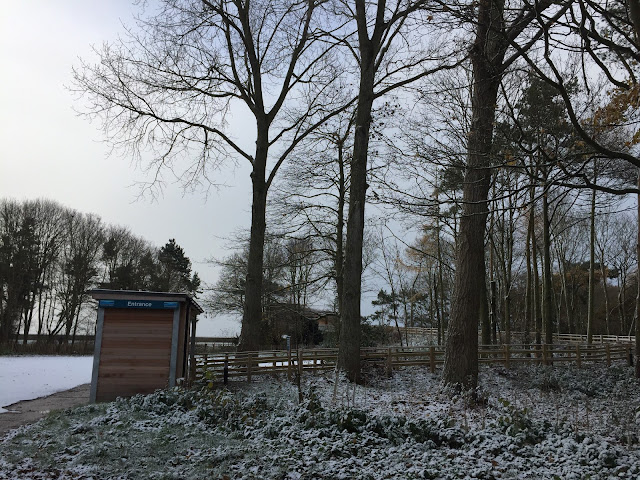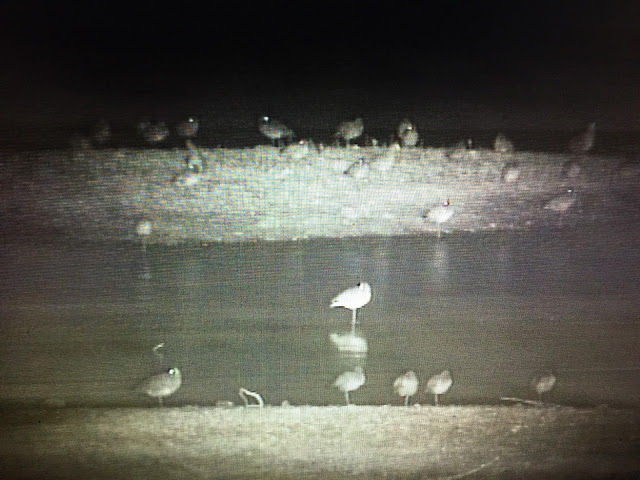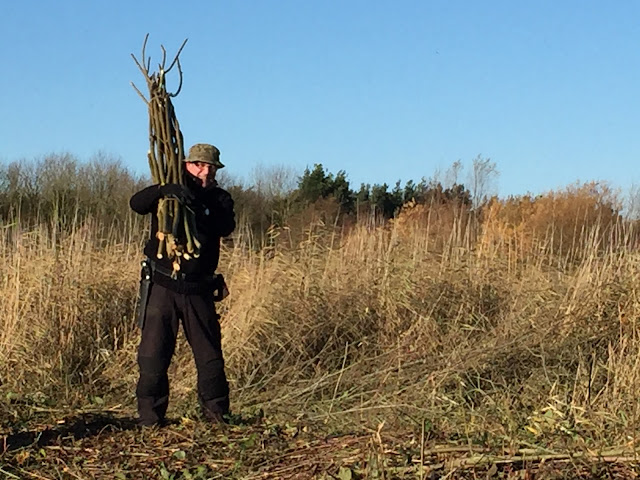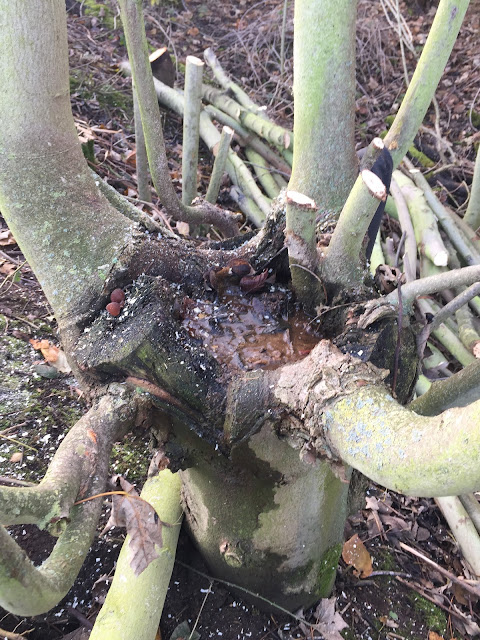Hopefully they'll linger around for breeding season. We have seen the 'floaty' display flight around Watton NR in recent years without output - so something to keep an eye out for if you're frequenting North Marsh. Their bigger cousin the great white also flew over us in the cold of mid December too and seems to not be going anywhere this winter. The supermoon made for impressive display at North Marsh as dusk fell:
The season changed rapidly after the last posting from some nice autumn shades Sue Murray:
To some festive snow:
Of course a bit of ice makes for some great photo opportunities - such as by Tony McLean here:
A stunning scene nearly as good as some frozen sludge:
Perhaps only appreciated by Peter Izzard and I! The freezing process is very necessary in the management of the lagoons and marshes at Tophill. The sediment laden water settling from the treatment works is full of goodies that bring all the waders down in the season. The only snag is that over time the sludge in the base of the lagoons builds up and complicates and restricts draining them for the wader passage (a very sweeping summary!!). The apparent sediment is actually a 'colloidal sludge' which whilst hydrated remains present gradually filling the water body. By freezing or drying however, it breaks down the bonds reducing its volume to a fraction of its original size and never rehydrates. Thus leaving the lagoons ready for another years work and a wader bonus. One of the many intricacies of the site!
Unfortunately last winter we had about one mild frost - so days of ice cover are most welcome:
Before we did re-fill the north lagoon (one needs keeping in operation at any given time) the redshank were a nice sight with perhaps the best winter presence of the species for some years:
Just before re-filling a pipit was reported feeding on the exposed mud - always well worth checking out - but alas just a standard meadow rather than anything exotic - Bill Eggleton:
Up to 6 green sandpipers continued the theme of a late wader passage and a black tailed godwit continues to be a fixture around the southern site - Roy Lyon:
The south marsh continues to hold the curlew roost on a night - recently reaching a year maxima of 47 on the night vision camera:
Perhaps the greatest spectacle has been in the reedbeds around the marsh - or at least above it:
The nightly spectacle through autumn was pretty spectacular:
In excess of 2,000 were present some nights - attracting in the usual array of predators. This green wing tagged hawk and owl trust marsh harrier was doing its best to pluck roosting birds from the reeds:
To be fair though the sparrowhawks appeared to be having much greater success as they whipped those stirred up by the harrier from under its talons. The marsh harriers have been pretty active with at least two more individuals present over the rest of the reserve too:
And red kite for bit of variety:
Work has continued all first half of winter on the perimeter of the marsh prepping ready for the fox fence to be installed in the second:
Cliff grafting hard as ever:
Alas Ken never made Countryfile being cut from the filming schedule a few days prior as is ever the case - so back to mundanity but with good results - lots of willow encroachment removed from the reedbeds:
The results is a habitat of scale as discussed in the last posting:
Working in the environment the results are already visible with birds using it as a main flight corridor in preference to the river and should work well for the season. Again our apologies for the disturbance over winter; but needs must as time races on now we're into spring.
From my perspective it is now spring with tawny's setting territories up, wildfowl in full plumage and foxes scenting. Snowdrops will be very close and from there its all the way down hill - so regardless of the weather to come we have very much turned a corner. Various pollards finished and done:
A few other choice pollard pics showing the wealth of habitats that they make - and why they equal wildlife and biodiversity:

And yet another reason why we don't want tall trees developing next to the marsh. From below we had this down as a squirrel drey - but its actually a corvid nest from last year:
Just what we want less than 50 feet from where the little ringed plovers were nesting...
So with the cold weather we were expecting great exotica, smew, white winged gulls and the like? In reality as with the summer wader season the winds have been all westerly in origin and coming off Iceland and the like rather than the Baltic as one would want. As such oddment pink footed geese Roy Lyon:
A few fieldfare made it across - Tony McLean:
But only two woodcock recorded to date. Again more passerine excitement with a chiffchaff in D woods - we hoped it may be an eastern tristis variety - but again just a standard one:
Blackcap also overwintering too. Stonechats recently spicing things up a little - Darren Smith:
The best bird of the last few weeks has undoubtedly been the Caspian gull / s that graced us in late November:
Better shot by Martin Hodges whom found it - with more on his blog:
Certainly the best 'eastern' to grace us as yet. Some Siberian conditions would be nice to spice things up some more. But we've also got a lot of work to do this winter so bad weather would be best avoided...
Still plenty of regular Tophill wildlife about - kingfishers on north marsh - Brian Colley:
Otter - Neil Murray:
Goldcrest - Darren Smith
Treecreeper - Brian Colley:
And a smart lesser redpoll - Francis Bell:
A timely picture given it is about to become extinct on new years day; The BOU is as of the 1st adopting the IOC world list. On this list common 'mealy' redpoll (a rarity at Tophill as for us its confusingly not common - but is on the list) has been lumped together with the lesser redpoll - our typical western European winter bird as above.
For full details see here
UPDATE
On further guidance (thanks Stuart!) it appears that lesser redpoll has been given a reprieve contrary to my initial reading above earlier in the year, and the IOC has instead recognised it! See the December 2017 BOU list here. So as such Tophill Low has just broken the 270 species barrier with the split of taiga and tundra bean goose. We had an informal sweepstake on the next new species for the site amongst the regulars. Its fair to say no one circled lesser redpoll!
Such is the joy of birding; A huge amount of research is constantly going on and advances in DNA are meaning species are being assigned, moved or removed all the time (such as the Caspian gull above which until recent times was but a herring gull). Another job for me is to update the Tophill list as in addition to the 270 - a lot of species have changed places or latin names. Proof again you can never stop discovering or learning with wildlife!
Its unlikely this will make much impact for us on the 1st however. Many of you will be familiar with our 'Year Listing Day' in which we aim to get as many species as possible on the 1st of the 1st. Surpassing last years hefty 78 species tally will be a difficult feet we reckon but we'll give it a good shot.
Two walks heading out at 10am and 13:30pm with a running tally in the reception hide. For anyone who wishes we'll be sponsoring Jean Thorpe Wildlife Rehab (details here) with an option of 10p a species. Jean helps us out with injured wildlife both from the reserve and brought by the public so its great to help her out.
Thanks as ever to everyone's help and support either working on or visiting the reserve in 2017 and we look forward to a bountiful breeding season and rarity laden migration...








































